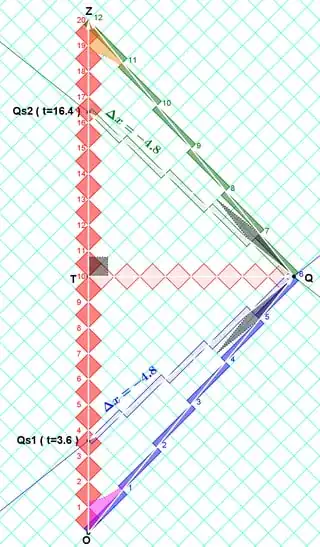My question was just special relativity without U-turn (or before
U-turn).
Unfortunately, you did not make this clear in your question. There is no clear definition of who is older when there is no turnaround. For example, we can find an observer who considers the Earth and Bob to go one way and Alice going away in the opposite direction at the same speed as Bob. From this new observer's point of view, they are both the same age; Bob considers himself to be older than Alice, and Alice considers herself to be older than Bob. No one in the universe can say with absolute certainty who is older in this scenario. If Bob decided he was missing Alice and chased after her, it would turn out that Bob would be younger than Alice when he caught up with Alice. (This is the opposite of the result in the classic twin paradox.) In your proposed scenario where everyone is always moving inertially, everyone will have different opinions about the ages. They will also have different opinions about the separation distances, which appears to be what the rest of your question is about, and I address that below:
When Alice has aged by $1 \ \text{year}$, Bob has aged by $7 \ \text{years}$.
This is as measured by Bob.
For a gamma factor of $7$, the velocity of Alice measured by Bob is $$\frac{v}{c} = \sqrt{1-1/7^2} \approx 0.98974332.$$ After $7 \ \text{years}$ by Bob's clock, Bob will calculate that Alice has travelled a distance of $0.9874332 \times 7 = 6.9282 \ \text{ly}$.
After Alice has accelerated away from Earth and reached a constant velocity, she will measure the proper distance to the distant galaxy as $6.9282/7 = 0.989743332 \ \text{ly}$ in her new reference frame. When Alice arrives at the distant galaxy, she notes that $1 \ \text{year}$ of her proper time has elapsed, so she calculates her velocity for the trip to be $d/t = 0.989743332c$, which is the same as the speed Bob measured, so no contradictions there. It will take Alice another year of her proper time to return to Earth, so when she gets back home, she will have aged by $2 \ \text{years}$ during her round trip, and she will notice that Bob has aged by $14 \ \text{years}$ during her absence.
What is the distance separating Alice and Bob at the U-turn? For
Alice, it is $1 \ \text{year}$ at $0.99c$, so $0.99 \ \text{ly}$? For Bob, it is $7 \ \text{years}$ at $0.99c$, so $6.93 \ \text{ly}$.
This is essentially correct, and our results agree when we allow for rounding. In a nutshell, when Alice is travelling, she measures the distance to the galaxy as $1/7$, the distance that Bob measures to the galaxy. To Alice, a rod stretching from the Earth to the galaxy is moving relative to her and is length contracted by a factor of $7$.
For Alice, during her round trip, the distance between Earth and the galaxy really was just under a light year, and since she can consider herself to be stationary, from her point of view, the galaxy was travelling towards her at $0.989743332c$. It took the galaxy a year of its time to arrive at her location. When she briefly stopped at the galaxy to turn around, she would have noticed the distance to Earth briefly appeared to be $7 \ \text{lightyears}$ again.
To an observer which is permanently moving at $0.98974332c$ relative to the Earth, the distance from Earth to the galaxy is permanently just under a light year, and it takes $2 \ \text{years}$ for a light signal to travel from Earth to the galaxy and back by his measurements and it takes about $2 \ \text{years}$ by his measurements for a rocket travelling at close to the speed of light to travel from Earth to the galaxy and back.
One point of view is that Alice has travelled nearly $14 \ \text{lightyears}$ in $2 \ \text{years}$ of her proper time, and this appears to exceed the speed of light. However, this is not the case. This is not the normal way to measure speed. Speed is coordinate distance divided by coordinate time in a given reference frame. Using time measured in one reference frame and distance measured in another gives odd results. This way of measuring speed is called proper velocity or celerity. There is no suggestion that Alice has exceeded the speed of light. If a light signal is sent from Earth to the galaxy when Alice sets off to the galaxy, the light signal arrives at the galaxy before Alice arrives, and all observers will agree on this observation.
